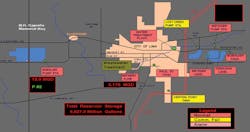Edge computing thrives in increasingly capable, embedded servers
This is Part 2 in a five-part series about edge computing. Read:
- Part 1: What and where is edge computing?
- Part 3: Edge computing provides flexibility for mobile applications
- Part 4: How a data separation strategy to edge computing is effective for managing information
- Part 5: Six steps to implement effective edge computing
Recent, fancy buzzwords aside, the place where most edge computing happens is in the increasingly capable and embedded servers that process and coordinate all the data coming in from sensors, I/O, PLCs and other devices.
When the U.S. Environmental Protection Agency (EPA) asked the City of Lima, Ohio, to reduce its discharges to the local Ottawa River to just five per year, the utility knew it needed to increase flow through its wastewater treatment plant (WWTP) from 55 MGD to 70 MGD during peak wet weather, add wet-weather maximization at the plant level to treat as much as possible during big rain events, upgrade its storm sewer overflow (SSO) basins, and modernize its old controls. The municipality's wastewater infrastructure consists of four above-ground reservoirs with about 14.5 billion gallons of available water, 32 lift stations, three underground gate structures, five combined sewer overflow (CSO) structures, and five radio repeater sites (Figure 1). The municipality is also building a $46 million, 13-MG CSO basin, fixing underground CSO gates to regulate maximum flow, and rebuilding the head of its plant to reach its 70-MGD goal.
Figure 1: To reduce discharges and increase flow capacity to 70 MGD, the water/wastewater treatment facility in Lima, Ohio, is upgrading infrastructure and modernizing controls for its 32 lift stations, four reservoirs and other facilities with new PLCs and panels, streamlined software and HMI screens, radios for telemetry, new fiber-optic ring networking, and virtual machines (VM) running ThinManager software, all relying on a fault-tolerant ftServer from Stratus Technologies, which houses eight VMs, including domain controller and historian server, and provides and added backup and recovery layer. Source: City of Lima
"We serve about 30,000 customers in our city limits, as well as surrounding communities and local businesses, including General Dynamics, Proctor & Gamble, Husky refinery, local hospitals and service industries," says Matt Fiedler, IT programmer and process control specialist, City of Lima. "Our process control goals were bringing our distributed control system (DCS) up to industry standards by replacing old 'spaghetti code' and streamlining our HMI screens; upgrading our remote lift stations with new PLC panels and time-saving GE MDS Orbit radios for telemetry; separating WWTP and WTP radio communications; replacing aging and failing PLCs at the WWTP; and creating a control standard that all future projects could follow."
Fiedler reports that Lima also sought to upgrade its 20-year-old, fiber-optic network with a new ring, adopt a fault-tolerant server to maintain uptime, add new switches in its PLC cabinets, virtualize all new servers, add backup and recovery functions, and improve plant-level and network security. In all, the utility implemented eight virtual machines (VM) running ThinManager software; nine Stratix switches, PlantPAx controls and FactoryTalk software from Rockwell Automation, and an ftServer from Stratus Technologies that serves as the foundation for these upgrades—all for about $46,000. The upgrade was achieved with help from system integrator Commerce Controls Inc. (CCI), a certified member of the Control System Integrators Association (CSIA), located in Novi, Mich.
"These solutions give us better data collection and display. We didn't have this luxury before. The old way took hours to extract data. Now, we can do it in minutes," explains Fiedler. "We'd looked at building a multi-server setup, but it wasn't best route because it could have been three times as costly. We found the Stratus servers were a no-brainer because they had a smaller footprint, as well as better fault tolerance support. We went with the ftServer FT4710 that allowed us to house eight VMs including our domain controller and historian server. In the two and a half years since we installed them, we've had zero issues, plus they give us an added layer of backup and recovery. We've increased security with the help of FactoryTalk's administration console. We're also adding security cameras and access control soon, and during rain events, the cameras will allow operators to monitor tanks without leaving their station."
Similarly, Stratus' CTO John Vicente adds that decentralizing includes decoupling computing, communications and storage from their formerly rigid, dedicated physical forms. "This means each function can be deployed wherever and to whatever extent based on the use case or environment where it's applied," says Vicente. "In our case, we converge IT and OT with our fault-tolerant ftServer and ztC platforms, bringing data center simplicity and protection to the edge, introducing value, serviceability, reduced downtime and security across edge applications. With this convergence of IT and OT, the IIoT edge enables the consolidation of OT workloads on modern fault-tolerant, virtualized IT platforms while enabling automation and machine-based analytics applications to be run locally without interruption."







